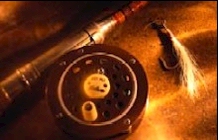If I
get into fish immediately, he hangs around to watch. If things are a bit
slow, heíll wander off into the willows and look for a cool spot to take
a nap.
On just my first cast, a pan-sized cutthroat rolled over the hopper
and took off on a downstream run. Stripping line in quickly to keep up
with the fishís retreat, I was able to land the little mountain jewel
without putting too much stress on it ó an important consideration with
water temperatures at their peak in late July. The cutthroat, about 10
inches long, positively glimmered in the afternoon sun; the telltale red
gash was deep and brilliant beneath its gills. Its tail was dotted with
hundreds of small black dots, a marked difference when compared to its
close relative, the Yellowstone cutthroat, which sports larger, less
dense dots on its tail and body. I quickly released the fish and started
in search of my next victim.
Spooner, as it turned out, hung around most of the afternoon.
Prime water
From the trailhead at Bear Creek, the best water is about a 30-minute
hike upstream. Simply follow the easy trail upstream for about half an
hour and then start fishing. Along your way, youíll see plenty of
inviting water, and if you canít resist, give it a shot. But Iím telling
you now, the streamís bigger fish ó the resident trout that live in Bear
Creek all year long ó make their home in the creekís upper reaches.
Itís possible to fish the stream right at the trailhead, but Iíve
never had much luck with larger trout there ó Iíve caught plenty of
little ones, though.
As you hike upstream, keep an eye out for beaver activity. If you
come across a beaver pond, donít hesitate to give it a try ó the dams
slow the water and provide great habitat for insects. As a result, the
cutthroats will gather there and grow a bit bigger.
Donít be discouraged by the streamís cloudy appearance. While it will
run mostly clear by mid-summer, it quickly dusts up after a storm and
never really runs perfectly transparent like other streams in the area.
At its best, the water runs out of the mountains with an inviting green
tinge to it. And watch your footing while you wade ó a thin layer of
silt almost always covers the streambedís rocks, and if youíre not
careful, youíll end up good and wet.
The fish
Bear Creekís cutthroats arenít large ó youíll probably catch more
six- or eight-inch fish than anything else. But thereís hope in this
stream ó every now and then youíll latch on to a 12-inch mauler that
will test light tackle and really put on a show. Iíve never caught big
cutthroats on Bear Creek, just lots of them.
To get into the streamís bigger fish, itís best to show up early in
the season ó by the middle of June, Iíve found that most of the fish
that ran up the creek to spawn are on their way back to Palisades
Reservoir, where they make their home the rest of the year. And, in low
water years, the fish may never even make the run at all, choosing to
remain in the reservoir rather than deal with warming water
temperatures.
The real treasures of Bear Creek are the aggressive resident fish who
have forsaken life in the lake for a spartan existence in the stream.
They donít get very big, but a 12-inch cutthroat hooked in heavy cover
can provide plenty of challenge for the fisherman armed with light
tackle.
In the fall, itís also possible to catch brown trout. A few of
Palisadesí resident browns use the stream as a spawning ground, but itís
rare to hook into a bronzeback, even when theyíre in the stream.
The flies
Early in the year, approach Bear Creek with really basic patterns.
The stream environment, while not sterile, isnít nearly as productive as
that of nearby Palisades Reservoir, so a flashy attractor pattern like a
Royal Coachman or a Yellow Humpy will usually draw plenty of strikes.
Later in the season, say from the middle of July on, the fish dine on a
buffet of terrestrial bugs ó grasshoppers, crickets, ants and beetles.
Arm yourself with some good terrestrial patterns, size 12 to 14, and you
wonít be disappointed. Also, with these big patterns, your chances of
latching on to one of the streams bigger fish are pretty good.
How to get there
Take U.S. Highway 26 east of Idaho Falls and follow it to Irwin. Take
a right at Palisades Dam, drive across the dam and follow the signs to
the Bear Creek trailhead on a serviceable dirt road maintained by the
Forest Service.





